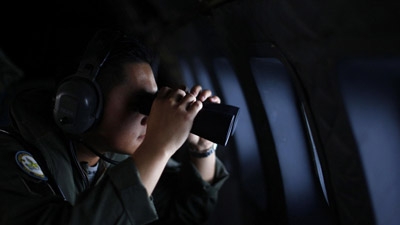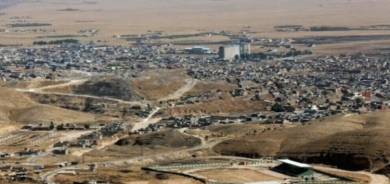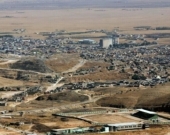Top 10 theories on Malaysia jet mystery

1. A fire takes MH370 to Langkawi Island
Aviation blogger Chris Goodfellow assesses the situation from the “pilot’s viewpoint” and said he has found a simple explanation for the jet’s disappearance on March 8. He says the loss of transponders and communications systems could be explained by a fire that prompted the pilot to head to the nearest airport after the communications blackout. He notes that Malaysian military radar had tracked the plane on a southwesterly course back across the Malay Peninsula into the Strait of Malacca.
"This pilot did all the right things. He was confronted by some major event onboard that made him make that immediate turn back to the closest safe airport," Goodfellow argues.
"Actually he was taking a direct route to Palau Langkawi, a 13,000ft (4,000m) strip with an approach over water at night with no obstacles. He did not turn back to Kuala Lumpur because he knew he had 8,000ft ridges to cross. He knew the terrain was friendlier towards Langkawi and also a shorter distance."
Goodfellow concluded that while the pilot had the right idea to head to the closest runway, he didn’t have enough time to make a safe landing.
2. Under the radar
Investigators are questioning whether the passenger jet may have slipped past radar, crossing international borders and undetected land.
Analysts told CNN that radar does have some blind spots, and it's possible to fly at lower altitudes to avoid being spotted.
Jeffrey Beatty, a security consultant and former FBI special agent, told the news network: "It certainly is possible to fly through the mountains in that part of the world and not be visible on radar. Also, an experienced pilot, anyone who wanted to go in that direction, could certainly plot out all the known radar locations, and you can easily determine where are the radar blind spots.”
"It's the type of things the Americans did when they went into Pakistan to go after Osama bin Laden," he added.
3. Making its way to Maldives
Maldives eyewitnesses reportedly saw a “low flying jumbo jet” at around 6:15 a.m. on March 8, the day the Malaysian airliners disappeared, The Telegraph reported on Tuesday. It was also flying north to south-east, witnesses told The Haveeru news organization.
“I've never seen a jet flying so low over our island before. We've seen seaplanes, but I'm sure that this was not one of those. I could even make out the doors on the plane clearly,” one witness said.
But Malaysian Transport Minister Hishammuddin Hussein told reporters at a news conference in Kuala Lumpur Wednesday afternoon that the Maldives air force chief had informed him that the reports were "not true."
4. Arrived at Andaman Islands
As the plane was reportedly heading in the direction of India's Andaman and Nicobar Islands, speculation has arisen that the plane was able to land there, with “reports that the military radar there might not even have been operating, as the threat level is generally perceived to be low,” according to the BBC.
Former BA 777 pilot Steve Buzdygan was quoted as saying that if the plane had been stolen, this might be the best place to land it secretly as there are more than 570 islands, only 36 of which are inhabited.
But the editor of Andaman Chronicle newspaper told CNN that the report should be dismissed as he believed monitoring by the Indian military would prevent an airliner being able to land there unnoticed.
5. Waiting to attack
Another theory is that the plane is safely hiding somewhere and will be used again to commit a terrorist attack, similar to 9/11. The theory suggests that the plane will be, “refueled and fitted with a new transponder before taking off to attack a city," the BBC reported.
Recently, an alleged plot by Malaysian Islamists to hijack a passenger jet, in a similar style to the Sept. 11, 2001 attacks, has been linked to the disappearance of Flight MH370, Britain’s Telegraph reported on Saturday.
Saajid Badat, a British-born Muslim from Gloucester, had said that four to five Malaysian men had been planning to take control of a plane, using a bomb hidden in a shoe to blow open the cockpit door, according to the newspaper.
In one of the most shocking revelations, Badat said that one of the Malaysian jihadists he met in Afghanistan was a pilot.
6. Hiding in Kazakhstan
The flight could have hypothetically reached Kazakhstan's air space, but it would have been detected there, the Kazakh Civil Aviation Committee said in a detailed statement sent to Reuters.
"Even if all on-board equipment is switched off, it is impossible to fly through in a silent mode," said the statement signed by the committee's deputy head Serik Mukhtybayev. "There are also military bodies monitoring the country's air space."
But light aircraft pilot Sylvia Wrigley, author of Why Planes Crash, told BBC that landing in a desert might be possible and certainly more likely than landing on a beach somewhere. "To pull this off, you are looking at landing in an incredibly isolated area," said Wrigley.
7. In the mountains of Pakistan
Media tycoon Rupert Murdoch tweeted to his over 500,000 followers that he suspected the plane was in a remote area of Pakistan.
"World seems transfixed by 777 disappearance. Maybe no crash but stolen, effectively hidden, perhaps in northern Pakistan, like Bin Laden," he wrote on Sunday.
Pakistan has reiterated a denial of the possibility multiple times.
Shujaat Azeem, Pakistan’s assistant to the prime minister on aviation, said: "Pakistan's civil aviation radars never spotted this jet, so how it could be hidden somewhere in Pakistan?"
Critics, however, say the notion that the missing Malaysian plane is in Pakistan is far-fetched for multiple reasons, the most obvious of which is that air space between India and Pakistan is some of the most watched sectors in the world by military radars, BBC reported.
Furthermore, despite the vast open lands in northern Pakistan, the region is still under close surveillance by satellites and drones.
8. There was a struggle
Although multiple theories have arisen to explain why the plane may have intentionally flown off course, few explanations account for the plane’s quick ascent above its ‘ceiling’ of around 45,000 feet and then its drastic descent.
Steve Buzdygan, a former BA 777 pilot, told BBC that big fluctuations in altitude suggest that there was a struggle. While cockpits post-9/11 were reinforced to minimize the chance of a takeover, there are still ways hijackers can access it.
Buzdygan says in a hypothetical hijacking, he would try to “disorientate and confuse the hijackers by throwing them around,” explaining the erratic flying patterns of the jet.
9. Mouths shut on ‘taboo’ suicide theory
A remaining and taboo theory investigators must consider is pilot suicide. While such incidents have occurred before, the topic still remains a distasteful scenario investigators rarely talk about bluntly.
In 1999, EgyptAir Flight 990 crashed into Atlantic Ocean killing the 217 people onboard. Despite the fact co-pilot Gameel el-Batouty turned off auto pilot and flew the plane downward while repeating: “I rely on God,” the 160 page report regarding the crash never once mentioned the word ‘suicide,’ reported Agence- France Presse.
Instead, the reason for his actions “was not determined.”
SilkAir Flight 185 also crashed into a river in 1997 during a flight from Jakarta, Indonesia, killing all 104 passengers and crew. A U.S. investigation found that the Boeing 737 had been deliberately crashed, but an Indonesian investigation was inconclusive.
Despite the past cases of pilots intentionally bringing down the plane, AFP reported that a 2014 study by the Federal Aviation Administration said only 0.3% of fatal aviation accidents were a result of pilot suicide.
Malaysia's government said police on Saturday searched the homes of both the pilot and the co-pilot of the missing Malaysia Airlines jet. It said police were examining an elaborate flight simulator taken from the home of 53-year-old pilot Zaharie Ahmad Shah.
10. A perpetual mystery
As an exhaustive international search has produced no sign of the Boeing 777, one particular question has arisen that is dragging the airline industry into an unsettling zone: What if we never know what happened to flight MH370?
"When something like this happens that confounds us, we're offended by it, and we're scared by it," Ric Gillespie, a former U.S. aviation accident investigator who wrote a book about Earhart's still-unsolved 1937 disappearance over the Pacific Ocean told the Associated Press.
"We had the illusion of control and it's just been shown to us that oh, folks, you know what? A really big airliner can just vanish. And nobody wants to hear that."
Andrew Thomas, the editor-in-chief of the Journal of Transportation Security, told Associated Press that part of the problem is that airline systems are not as sophisticated as many people might think.
He said one fact that proves this is that airports and airplanes around the world use antiquated radar tracking technology, first developed in the 1950s, rather than modern GPS systems.
Al Arabiya












